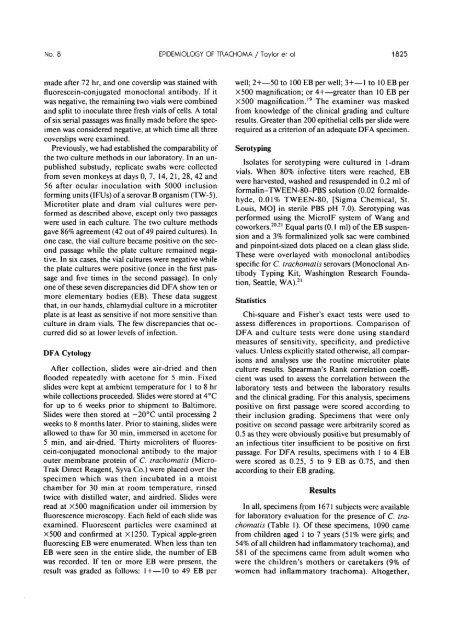The Epidemiology of Infection in Trachoma - Investigative ...
The Epidemiology of Infection in Trachoma - Investigative ...
The Epidemiology of Infection in Trachoma - Investigative ...
You also want an ePaper? Increase the reach of your titles
YUMPU automatically turns print PDFs into web optimized ePapers that Google loves.
No. 8 EPIDEMIOLOGY OF TRACHOMA / Toylor er a I 1825<br />
made after 72 hr, and one coverslip was sta<strong>in</strong>ed with<br />
fluoresce<strong>in</strong>-conjugated monoclonal antibody. If it<br />
was negative, the rema<strong>in</strong><strong>in</strong>g two vials were comb<strong>in</strong>ed<br />
and split to <strong>in</strong>oculate three fresh vials <strong>of</strong> cells. A total<br />
<strong>of</strong> six serial passages was f<strong>in</strong>allymade before the specimen<br />
was considered negative, at which time all three<br />
coverslips were exam<strong>in</strong>ed.<br />
Previously, we had established the comparability <strong>of</strong><br />
the two culture methods <strong>in</strong> our laboratory. In an unpublished<br />
substudy, replicate swabs were collected<br />
from seven monkeys at days 0, 7, 14, 21, 28, 42 and<br />
56 after ocular <strong>in</strong>oculation with 5000 <strong>in</strong>clusion<br />
form<strong>in</strong>g units (IFUs) <strong>of</strong> a serovar B organism (TW-5).<br />
Microtiter plate and dram vial cultures were performed<br />
as described above, except only two passages<br />
were used <strong>in</strong> each culture. <strong>The</strong> two culture methods<br />
gave 86% agreement (42 out <strong>of</strong> 49 paired cultures). In<br />
one case, the vial culture became positive on the second<br />
passage while the plate culture rema<strong>in</strong>ed negative.<br />
In six cases, the vial cultures were negative while<br />
the plate cultures were positive (once <strong>in</strong> the first passage<br />
and five times <strong>in</strong> the second passage). In only<br />
one <strong>of</strong> these seven discrepancies did DFA show ten or<br />
more elementary bodies (EB). <strong>The</strong>se data suggest<br />
that, <strong>in</strong> our hands, chlamydial culture <strong>in</strong> a microtiter<br />
plate is at least as sensitive if not more sensitive than<br />
culture <strong>in</strong> dram vials. <strong>The</strong> few discrepancies that occurred<br />
did so at lower levels <strong>of</strong> <strong>in</strong>fection.<br />
DFA Cytology<br />
After collection, slides were air-dried and then<br />
flooded repeatedly with acetone for 5 m<strong>in</strong>. Fixed<br />
slides were kept at ambient temperature for 1 to 8 hr<br />
while collections proceeded. Slides were stored at 4°C<br />
for up to 6 weeks prior to shipment to Baltimore.<br />
Slides were then stored at -20°C until processmg 2<br />
weeks to 8 months later. Prior to sta<strong>in</strong><strong>in</strong>g, slides were<br />
allowed to thaw for 30 m<strong>in</strong>, immersed <strong>in</strong> acetone for<br />
5 m<strong>in</strong>, and air-dried. Thirty microliters <strong>of</strong> fluoresce<strong>in</strong>-conjugated<br />
monoclonal antibody to the major<br />
outer membrane prote<strong>in</strong> <strong>of</strong> C. trachomatis (Micro-<br />
Trak Direct Reagent, Syva Co.) were placed over the<br />
specimen which was then <strong>in</strong>cubated <strong>in</strong> a moist<br />
chamber for 30 m<strong>in</strong> at room temperature, r<strong>in</strong>sed<br />
twice with distilled water, and airdried. Slides were<br />
read at X500 magnification under oil immersion by<br />
fluorescence microscopy. Each field <strong>of</strong> each slide was<br />
exam<strong>in</strong>ed. Fluorescent particles were exam<strong>in</strong>ed at<br />
X500 and confirmed at XI250. Typical apple-green<br />
fluoresc<strong>in</strong>g EB were enumerated. When less than ten<br />
EB were seen <strong>in</strong> the entire slide, the number <strong>of</strong> EB<br />
was recorded. If ten or more EB were present, the<br />
result was graded as follows: 1+—10 to 49 EB per<br />
well; 2+—50 to 100 EB per well; 3+—1 to 10 EB per<br />
X500 magnification; or 4+—greater than 10 EB per<br />
X500 magnification. 19 <strong>The</strong> exam<strong>in</strong>er was masked<br />
from knowledge <strong>of</strong> the cl<strong>in</strong>ical grad<strong>in</strong>g and culture<br />
results. Greater than 200 epithelial cells per slide were<br />
required as a criterion <strong>of</strong> an adequate DFA specimen.<br />
Serotyp<strong>in</strong>g<br />
Isolates for serotyp<strong>in</strong>g were cultured <strong>in</strong> 1-dram<br />
vials. When 80% <strong>in</strong>fective titers were reached, EB<br />
were harvested, washed and resuspended <strong>in</strong> 0.2 ml <strong>of</strong><br />
formal<strong>in</strong>-TWEEN-80-PBS solution (0.02 formaldehyde,<br />
0.01% TWEEN-80, [Sigma Chemical, St.<br />
Louis, MO] <strong>in</strong> sterile PBS pH 7.0). Serotyp<strong>in</strong>g was<br />
performed us<strong>in</strong>g the MicroIF system <strong>of</strong> Wang and<br />
coworkers. 20 ' 21 Equal parts (0.1 ml) <strong>of</strong> the EB suspension<br />
and a 3% formal<strong>in</strong>ized yolk sac were comb<strong>in</strong>ed<br />
and p<strong>in</strong>po<strong>in</strong>t-sized dots placed on a clean glass slide.<br />
<strong>The</strong>se were overlayed with monoclonal antibodies<br />
specific for C. trachomatis serovars (Monoclonal Antibody<br />
Typ<strong>in</strong>g Kit, Wash<strong>in</strong>gton Research Foundation,<br />
Seattle, WA). 21<br />
Statistics<br />
Chi-square and Fisher's exact tests were used to<br />
assess differences <strong>in</strong> proportions. Comparison <strong>of</strong><br />
DFA and culture tests were done us<strong>in</strong>g standard<br />
measures <strong>of</strong> sensitivity, specificity, and predictive<br />
values. Unless explicitly stated otherwise, all comparisons<br />
and analyses use the rout<strong>in</strong>e microtiter plate<br />
culture results. Spearman's Rank correlation coefficient<br />
was used to assess the correlation between the<br />
laboratory tests and between the laboratory results<br />
and the cl<strong>in</strong>ical grad<strong>in</strong>g. For this analysis, specimens<br />
positive on first passage were scored accord<strong>in</strong>g to<br />
their <strong>in</strong>clusion grad<strong>in</strong>g. Specimens that were only<br />
positive on second passage were arbitrarily scored as<br />
0.5 as they were obviously positive but presumably <strong>of</strong><br />
an <strong>in</strong>fectious titer <strong>in</strong>sufficient to be positive on first<br />
passage. For DFA results, specimens with 1 to 4 EB<br />
were scored as 0.25, 5 to 9 EB as 0.75, and then<br />
accord<strong>in</strong>g to their EB grad<strong>in</strong>g.<br />
Results<br />
In all, specimens from 1671 subjects were available<br />
for laboratory evaluation for the presence <strong>of</strong> C. trachomatis<br />
(Table 1). Of these specimens, 1090 came<br />
from children aged 1 to 7 years (51% were girls; and<br />
54% <strong>of</strong> all children had <strong>in</strong>flammatory trachoma), and<br />
581 <strong>of</strong> the specimens came from adult women who<br />
were the children's mothers or caretakers (9% <strong>of</strong><br />
women had <strong>in</strong>flammatory trachoma). Altogether,
















